‘Behemoth’ is a word which springs to mind or, perhaps more nautically, ‘leviathan’.
- Excellent build quality
- Cavernous lazarette
- Large volume hull allows two generous cabins
- 40-knot performance, but runs sweetly at 25 knots
Spanish-built newcomer has plenty of practical nous, style and performance to offer Kiwi boaters. The beamy Rodman Spirit 31 packs a lot of boat into its 9.5m length.
Living in New Zealand has many undeniable benefits, including our spectacular boating environment. However, one of the disadvantages of being so far from much of the rest of the world is that we sometime miss out on offerings from some of the world’s great manufacturers. Luckily, Auckland-based Your Marine has stepped up to fill the gap and bring us the Rodman Spirit 31, a superb example of Spanish boatbuilding prowess.
Although relatively unknown here, Rodman is one of Europe’s most respected brands with nearly 50 years of history building large commercial vessels and patrol craft, as well as an extensive range of pleasure craft. They have built over 15,000 vessels during this period, and the Rodman Spirit 31 embodies many of the innovative design features that they have become renowned for.
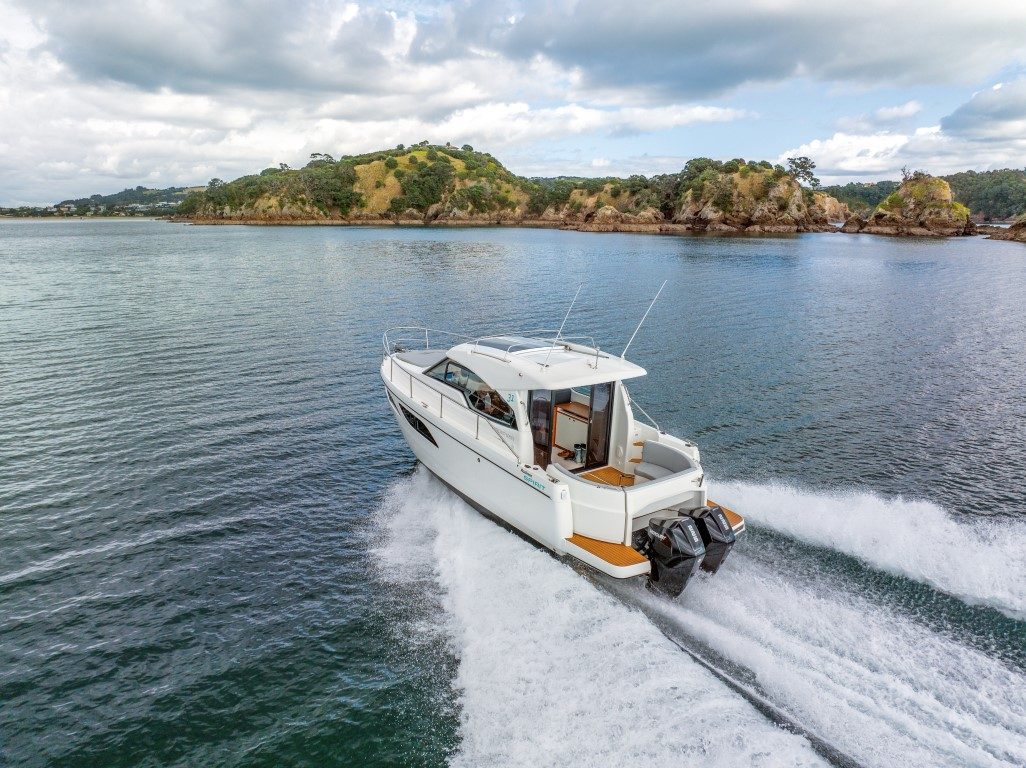
Somewhat unusually for a boat that is just short of the 10-metre mark overall, the Rodman Spirit 31 we tested is outboard powered. This model is available in both an open cabin and closed hardtop version, and it was the hardtop that we tested on a rare, fine late-autumn day in Auckland. This hull is also available as a diesel inboard option with single or twin shaft-drive configurations. However, Daniel Painter, director of Your Marine, said that the global trend is towards outboard power in the sub-10m category.
One of the key benefits of a twin outboard configuration is that very little hull space is lost to the propulsion system, with the motors mounted on a stand-off bracket that pushes them just out from the stern. This means the motors also do not require any cockpit space when they tilt up, so effectively the entire interior volume of the hull is available. That extra space has enabled Rodman’s designers to fit two full double-berth cabins, an appealing feature for owners wanting to treat their family or friends to an overnight trip.
The only downside of the outboards is a smaller boarding platform and relative lack of swim access off the transom, but again, the designers have come up with an innovation. The cockpit seats are curved and slide in a similarly curved track to either form a continuous couch with the stern seat, or to create a walkway through the swim platform on either side when open. This sliding seat arrangement does mean that almost the entire length of the Rodman 31 Spirit is accessible space, unlike many boats which ‘lose’ the boarding platform except for swimming.
A drop-in table means that al fresco dining in the cockpit is the way to go, and on our review we did just that as we enjoyed the rare sight of a clear sunny day! The stern seat swings up when you do need to access the outboard powerheads, and a hatch in the cockpit provides access to a cavernous lazarette which houses the fuel tank, batteries and ancillary systems. This space can also easily accommodate a tender, second fridge and all the toys you may need for a couple of weeks aways.
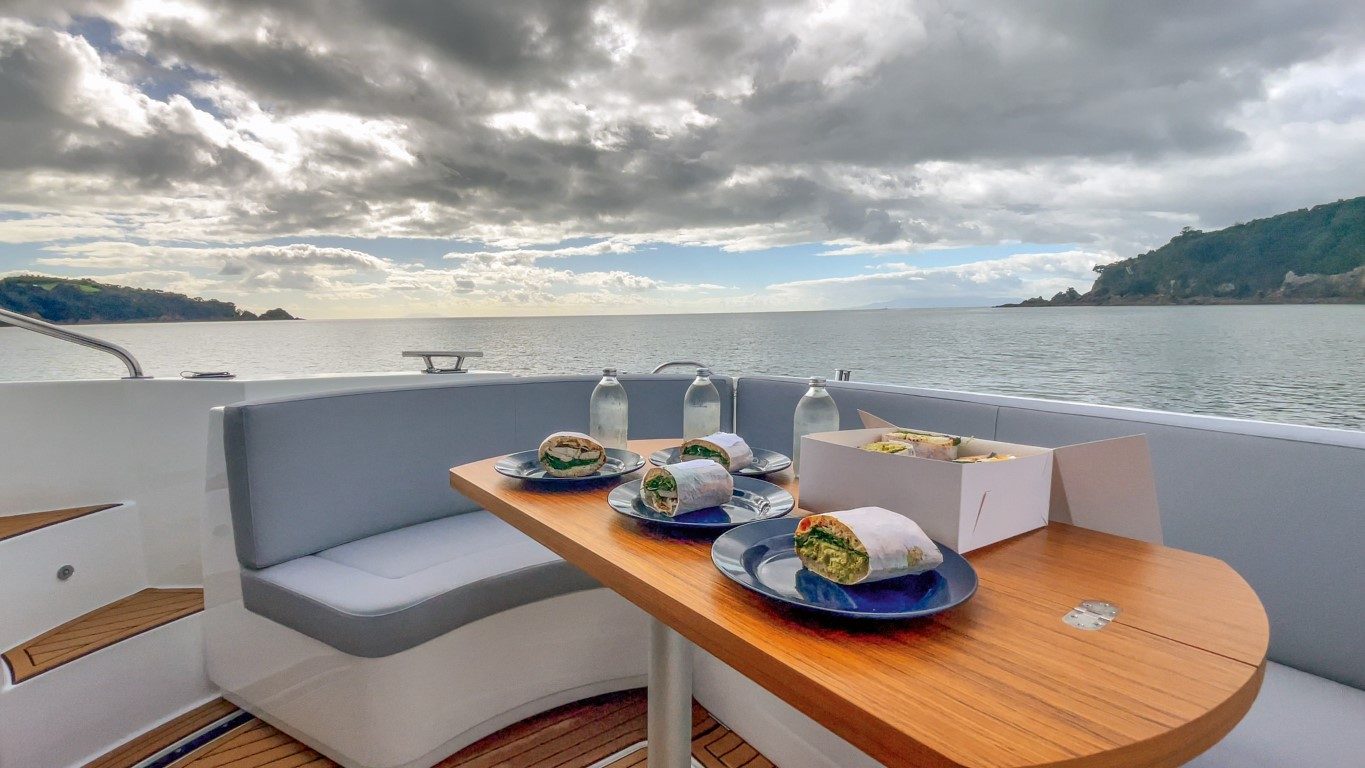
A tempered glass door leads into the saloon and galley area. The galley is hidden away under a fanfold countertop, which lifts to reveal a stainless two-burner hob and separate sink. A Dometic 12V stainless fridge and freezer just behind the skipper’s seat keeps food fresh and drinks cold, and we can attest to the effectiveness of this.
The port side features a long L-shaped sofa and dining table, which can be lowered to provide some extra sleeping capability. The cabin interior is beautifully finished with white cabinetry, grey upholstery and carpet, and woodgrain countertops. The sliding windows on both sides are themselves a marvel of design and engineering, with sliding panels inset into the expansive tempered glass side windows.
Sitting on the sofa you cannot help but look up to admire the Webasto electrically operated marine sunroof. A touch panel on the helm causes the 8mm safety glass panel to slide neatly open to the rear, giving full access to the blue sky above. A block-out blind and flyscreen can be pulled over the opening if required.
At the helm things are clearly laid out and visibility is excellent. A carbon-fibre dash panel contains everything that is needed – a 12-inch Garmin touchscreen MFD for chart plotter and fish finder, a Mercury VesselView display for managing the motors, analogue gauges for water, fuel and greywater, touch controls for the Lectrotab trim tabs and anchor winch, and a joystick for the bow thruster. Control of the motors is through a dual-lever Digital Throttle and Shift (DTS) unit, and this proved very easy to use. A row of conventional rocker switches, each with a pictogram showing what they control, eliminates any confusion.
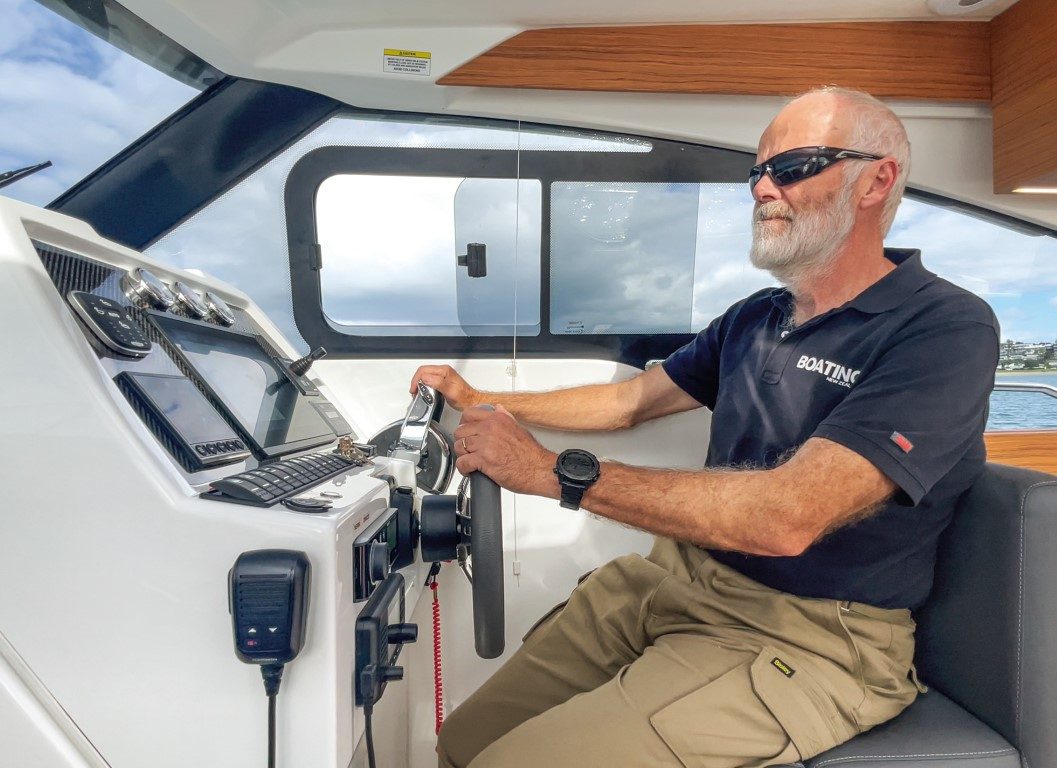
Stepping down the companionway past the galley to the cabins reveals a double guest cabin on the port side, with a full-sized double berth and a large side window with opening porthole. The starboard side features the spacious bathroom, with a porcelain basin, shower with curtain and luxury toilet. The main cabin up forward has another full-size double berth, windows on either side with opening portholes, an opening skylight hatch, and a hanging wardrobe. The width of the main cabin was surprising, showing how much volume they have managed to achieve with this hull.

Stepping back through the saloon into the cockpit, and access around the sides of the cabin is via a set of very generous steps, covered in SeaDek flooring like the rest of the cockpit. Walking along the side of the cabin is easy thanks to the recessed side decks providing secure footing, a high guard rail all around the boat, and a stainless handrail up on the cabin sides. A pair of optional stainless bars across the roof, much like a vehicle roof rack, can be used for carrying a dinghy or kayaks while keeping them well clear of the sliding sunroof.
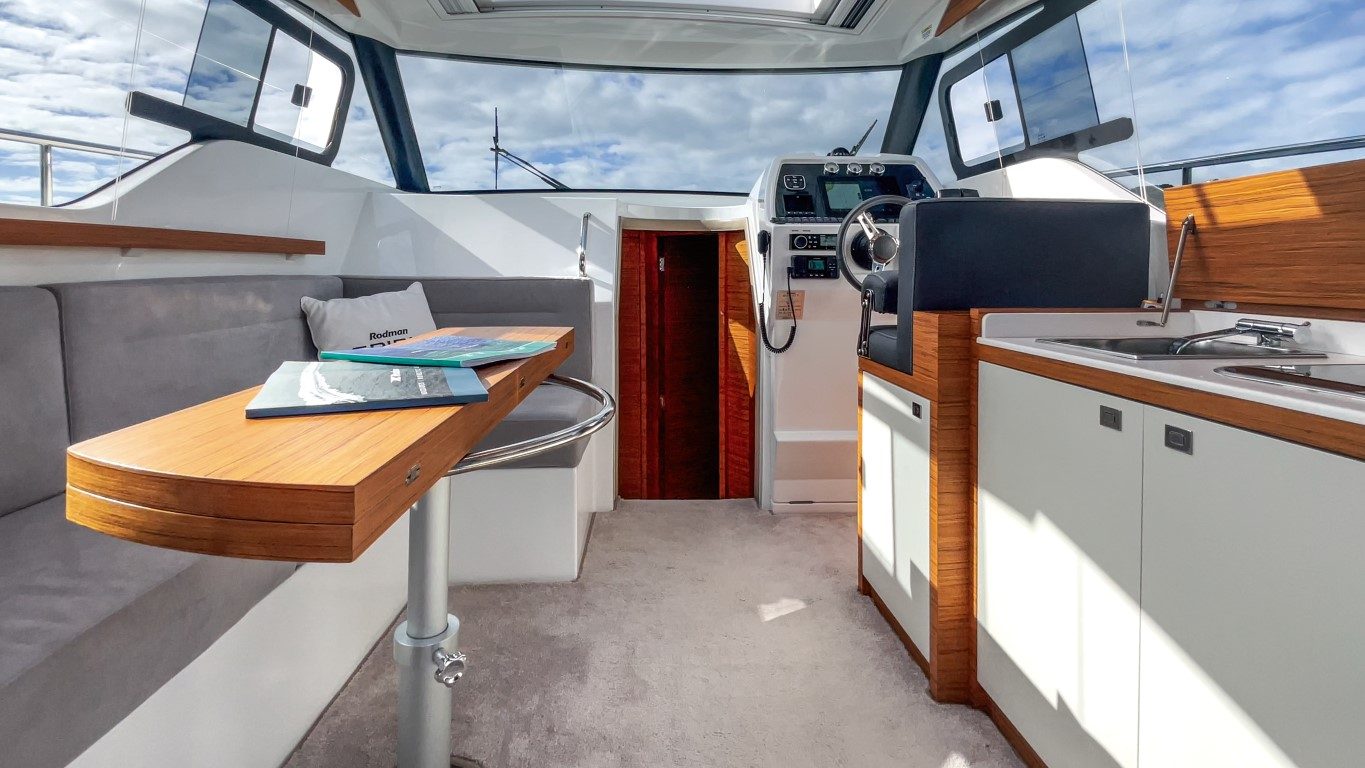
Up in the bow area, upholstered sun loungers and a sturdy bow rail make this a great area for sun lovers. The anchor winch and fairlead are well out of the way of toes. Quite evident from the foredeck is how wide and rounded the bow is at the deck level, which together with the near-vertical bow, provides that interior volume that we could see in the master cabin. The hull does slim down to an efficient vee at the waterline, to deliver good handling despite the volume.

Enough looking, it was time to head out. The twin Mercury 225hp four-strokes hummed into life, and we slipped out of the berth at Westhaven. The bow-thruster made it child’s play to navigate the tricky turn as we backed out the marina, and we were soon on our way. The motors are so far back, and shielded by the stern seat, that you can hardly hear them running at anything less than full throttle, so it was a very quiet trip out.
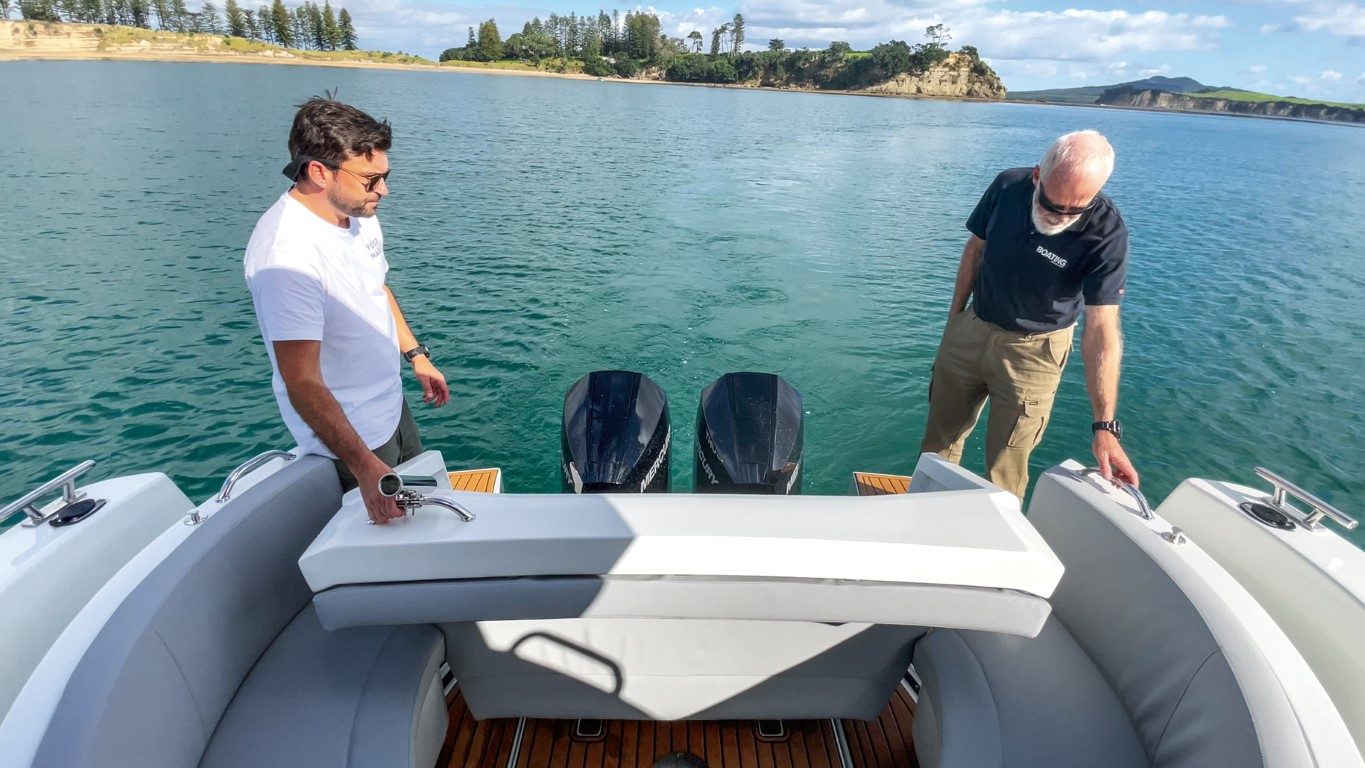
As we headed out, we checked a couple of consumption figures for the V6 3.4-litre normally aspirated Mercurys. The hull is easily driven and at 4000rpm she cruises comfortably at 24 knots using a total of just 60 litres per hour, both motors combined. This works out to less than three litres per nautical mile (2.71lpnm from 21-29 knots), so the 600 litres of fuel capacity gives a theoretical range in excess of 200 nautical miles. Not unusually for a boat like this, dropping the speed down to 16 knots used slightly more fuel per nautical mile, so that mid-20s speed is in the sweet spot. We did not push the engines flat-out, but she is capable of nearly 40 knots at her maximum 6000rpm.
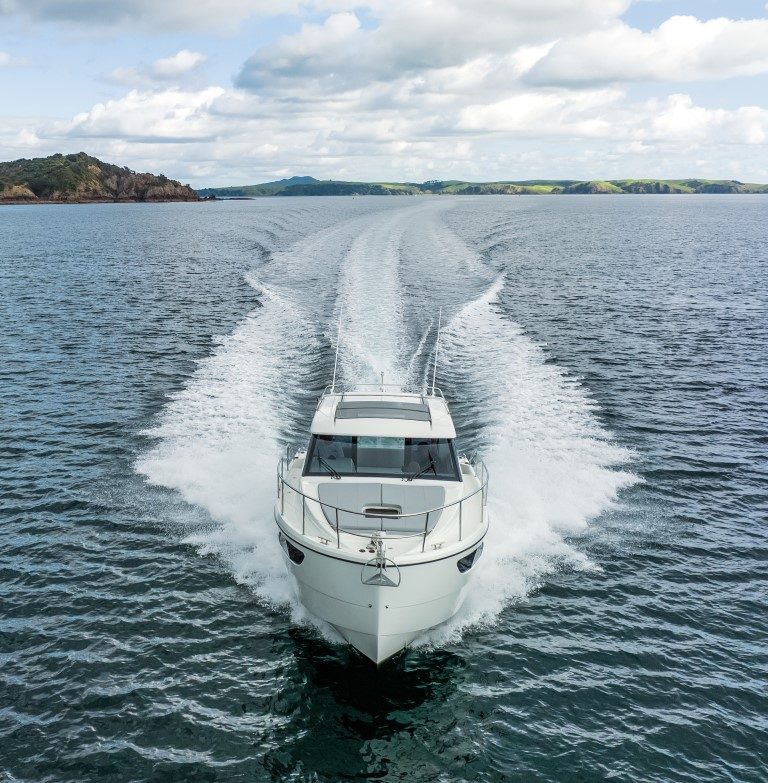
At our designated spot off Waiheke Island, we pulled into Oneroa Bay for a light lunch. While the photographer flew his drone for the aerial shots, we puttered around to find the best spot, then made the most of the pleasant sunshine. After taking care of some excellent gourmet sandwiches and sparkling water, it was time to have a more serious play.

As can be seen from the photos, the Rodman tracks straight as an arrow under power, creating a remarkably small wake for a vessel displacing around six tonnes. The steering was light but also very direct, and the hull, despite it’s 3.36 metres of beam, easily cuts through any head sea. We had excellent conditions so were not able to test her in a big chop, but she certainly seemed stable and comfortable.
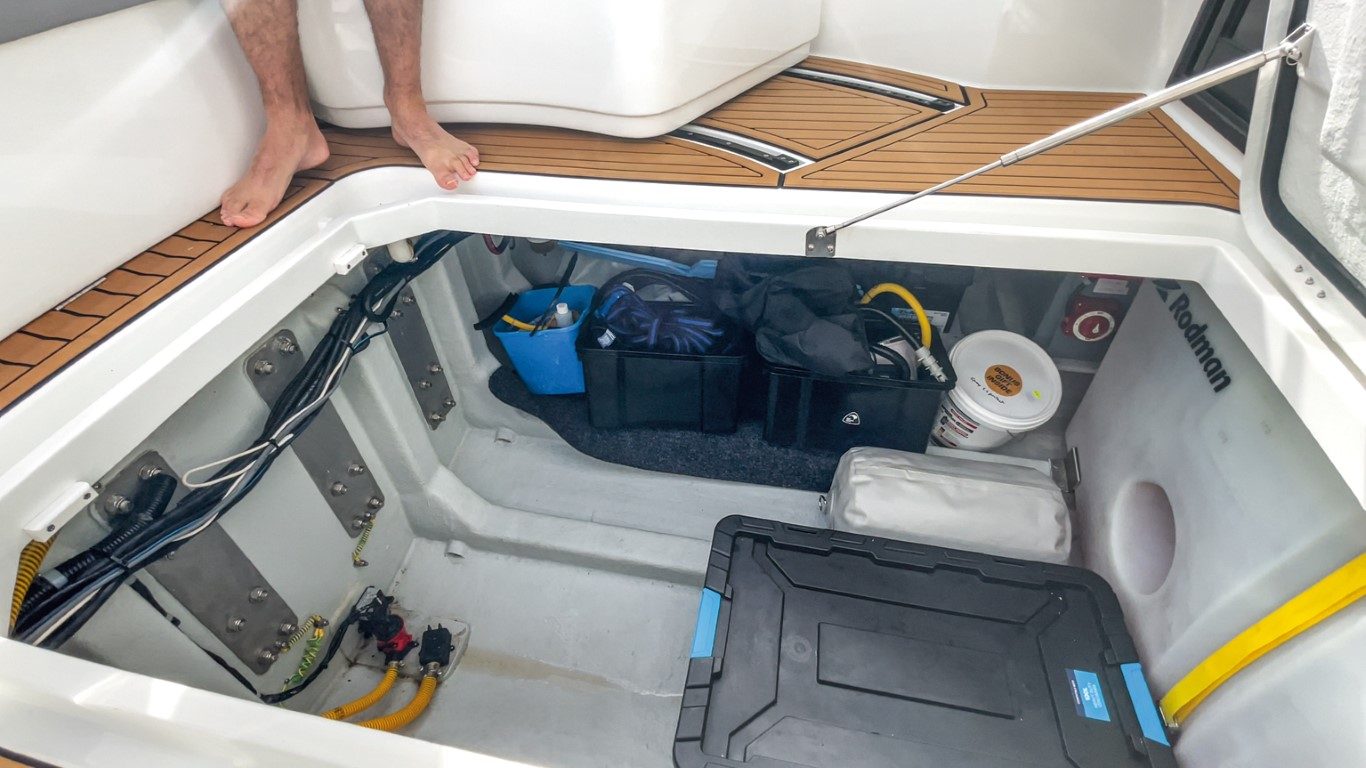
The Rodman Spirit 31 is a large-volume, functional and stable boat which nevertheless is fuel-efficient and comfortable to drive. The build quality is excellent, with many design features other manufacturers might envy. The reliability of the twin outboards outweighs slightly higher fuel costs, giving owners peace of mind out on the water, and also making this possibly the ideal boat for a shared ownership arrangement.
/>
‘Behemoth’ is a word which springs to mind or, perhaps more nautically, ‘leviathan’.
White Pointer has earned the respect of discerning customers in New Zealand and Australia, attracting a loyal and ever growing following for its high-quality, rugged and totally dependable aluminium trailer boats.
The hardtop SP635 shares the same underpinnings as the popular SF 635 which was a completely new model back in 2020.
The pride and joy of a multi-generational family, Bliss resides on a pier that’s home to a couple of other Elite motor launches – Sandspit Marina is a hot-spot for the Bill Upfold-designed vessels, with several calling this small marina home.